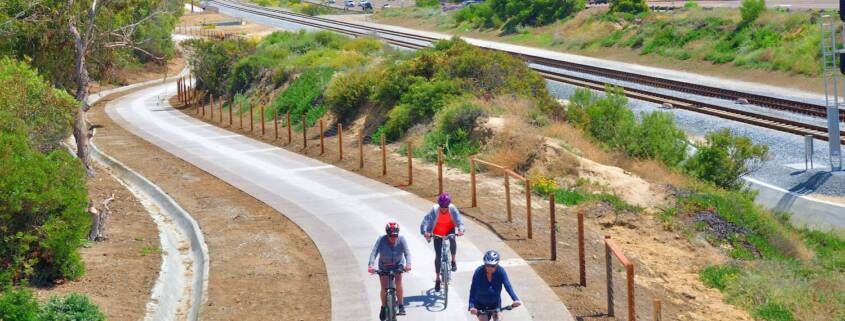Gearing Up for Bike Highways
The Bike Highways Bill, AB 954, one of CalBike’s sponsored measures, would create a pilot to build connected, protected bike networks in two California regions. This sounds exciting, but since California doesn’t have any bike highways yet, it’s helpful to step back and explain the concept.
What is a bike highway?
The most basic definition of a bike highway is a connected, protected bikeway network that allows people to move quickly and safely over longer distances. That might look like a scaled-down version of a car freeway, with limited access, interchanges, and even elevated sections to pass over other roads.
But a bike highway network doesn’t need all the bells and whistles to fulfill its mission of providing safe, swift passage for bike riders. Some communities already have many of the pieces of a bike network and they simply need to be knit together to create a bike highway.
The Ohlone Greenway, a Class 1 separated path that travels through multiple cities, following a right of way under elevated Bay Area Rapid Transit (BART) tracks and cutting through the middle of blocks beside parks, is an excellent example of what’s possible. It’s identified as part of the East Bay Greenway in a Caltrans study of Bay Area bike highways. The greenway has been extended over time, and there are plans to extend it further south; it could be extended and connected to other protected bikeways, either on- or off-street. To become a fully functional bike highway, the network would need improved street crossings, clear signage, and connections to more of the most common destinations in the region. The Caltrans study details what’s possible and outlines the benefits of building bike highways.
Another example is the LA River Path, an eight-mile Class 1 path that follows the Los Angeles River. The path is slated for expansion and is integral to LA’s plan for a car-free Olympics in 2028.
Other cities have segments that could be built out into bike highways. These might look like pathways through parks, beachside bikeways, rails-to-trails facilities, and protected bikeways on city streets. The key features are connection, safety, and speed.
As with all bicycle networks, the trickiest element is safe street crossings, particularly at busy intersections. Bike highways need intersections where bicycle safety is a primary concern, not a nice-to-have. Protected intersections could include bicycle traffic signals with bike-only phases.
Auckland example
Several years ago, Sam Corbett of Alta Planning + Design gave a presentation on the bicycle highway network in Auckland, New Zealand at the California Bicycle Summit. Auckland has an impressive network of separated bikeways, often with colorful pavement, sometimes elevated to allow continuous passage without navigating intersections.
While the realities of dense urban spaces and funding limitations may not allow California to build beautiful bike highways like those in Auckland, we can take them as an aspirational example. This bill is the first step on that journey.
View Sam Corbett’s presentation about Auckland for some inspiration!
https://drive.google.com/file/d/1f2c6YWm3vREpb4uBX-MWoBBD5pXzPiRs/view





